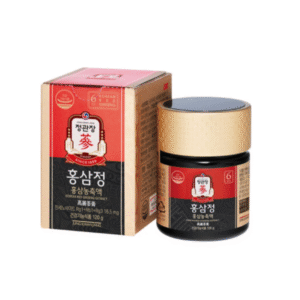The Modern Heart at Risk
Cardiovascular disease (CVD) remains the leading cause of death worldwide, responsible for an estimated 18 million deaths annually. Modern lifestyles—marked by high stress, sedentary habits, processed foods, and environmental toxins—contribute to hypertension, endothelial dysfunction, and atherosclerosis.
While advances in medicine have saved countless lives, there is growing scientific interest in botanical agents that support cardiovascular resilience through multiple mechanisms. Among them, Korean Red Ginseng (Panax ginseng C.A. Meyer) stands out for its dual role as an adaptogen and cardioprotective herb backed by both centuries of use and modern research.
1. The Heart and Circulatory System: A Delicate Balance
The cardiovascular system depends on three essential functions:
- Rhythmic cardiac output, controlled by electrical impulses and myocardial contractility.
- Vascular tone and elasticity, mediated by smooth muscle and nitric oxide signaling.
- Blood integrity, governed by coagulation, inflammation, and oxidative balance.
Disruption in any of these domains—through chronic stress, elevated cholesterol, or endothelial inflammation—can initiate disease. Effective prevention therefore demands holistic support, not merely symptomatic control.
2. What Makes Korean Red Ginseng Unique
Korean Red Ginseng differs from white or American ginseng through a traditional steaming and drying process, transforming its phytochemistry. Heat converts original ginsenosides into more bioavailable and potent derivatives such as Rg3, Rg5, and Rh2, which show superior activity in cardiovascular protection.
These compounds act across multiple biological pathways:
- Regulating blood pressure via nitric oxide synthesis
- Reducing oxidative stress and inflammation
- Modulating lipid metabolism
- Supporting vascular regeneration
This multitarget adaptogenic profile underlies the herb’s reputation as the “smart regulator” of cardiovascular function.
3. Mechanisms of Cardioprotection
3.1 Nitric Oxide and Endothelial Function
Healthy arteries rely on the continuous release of nitric oxide (NO), a molecule that relaxes smooth muscle and prevents platelet aggregation.
A landmark study in the Journal of Ethnopharmacology (2012) demonstrated that ginsenoside Rg3 stimulates endothelial nitric-oxide synthase (eNOS), enhancing NO bioavailability and improving arterial dilation.
This mechanism mirrors the action of certain prescription vasodilators—yet without causing hypotension or tolerance.
3.2 Antioxidant and Anti-Inflammatory Defense
Oxidative stress accelerates lipid oxidation and plaque formation. Ginsenosides Rb1 and Re act as free-radical scavengers, up-regulating antioxidant enzymes such as superoxide dismutase (SOD) and glutathione peroxidase.
In a 2018 Phytotherapy Research trial, supplementation with Korean Red Ginseng extract reduced C-reactive protein (CRP) and malondialdehyde (MDA) levels—biomarkers of systemic inflammation and oxidative injury.
3.3 Regulation of Lipid Metabolism
Hyperlipidemia contributes directly to coronary artery disease. Experimental data (Kim et al., Nutrition Research, 2015) show that ginsenosides down-regulate HMG-CoA reductase, the same enzyme targeted by statins, and improve HDL/LDL ratios without hepatotoxicity.
3.4 Protection of Myocardial Tissue
Animal studies indicate that pre-treatment with ginseng extract can reduce myocardial infarct size by up to 40 % after ischemia–reperfusion injury (Cardiovascular Toxicology, 2016). The mechanism involves reduced calcium overload and preservation of mitochondrial integrity.
4. Clinical Evidence in Humans
- Improved Circulation
A randomized, placebo-controlled study (Hypertension Research, 2006) found that adults consuming 3 g/day of Korean Red Ginseng for 8 weeks exhibited better arterial compliance and a mild reduction in systolic pressure. - Enhanced Endothelial Function
In The American Journal of Chinese Medicine (2011), subjects with metabolic syndrome experienced significant increases in flow-mediated dilation (FMD), an indicator of endothelial health, after ginseng supplementation. - Cholesterol and Blood Lipids
A meta-analysis (Li et al., Frontiers in Pharmacology, 2020) covering 12 clinical trials concluded that Korean Red Ginseng reduces total cholesterol and triglycerides, particularly in individuals with pre-hypertension or hyperlipidemia. - Stress and Heart Rate Variability
Adaptogenic modulation of the hypothalamic–pituitary–adrenal axis improves heart-rate variability (HRV), reflecting a balanced autonomic tone and reduced cardiovascular strain.
Collectively, these findings position Korean Red Ginseng as a safe adjunct for maintaining vascular flexibility, reducing oxidative burden, and enhancing overall cardiac efficiency.
5. Korean vs. Other Ginseng Species
| Type of Ginseng | Major Active Compounds | Cardiovascular Potency | Notes |
|---|---|---|---|
| Korean Red Ginseng (Panax ginseng) | Rg3, Rg5, Rh2 | ★★★★★ | Strong nitric-oxide activation, proven clinical data |
| American Ginseng (P. quinquefolius) | Rb1, Re | ★★★☆☆ | Mild sedative; limited data for hypertension |
| Siberian Ginseng (Eleutherococcus) | Eleutherosides | ★★☆☆☆ | Not true ginseng; less effect on blood flow |
The processing difference—steaming and fermentation—gives Korean Red Ginseng its biochemical edge, concentrating vasoprotective ginsenosides.
6. Integrating Korean Red Ginseng into Daily Heart Care
For preventive support, clinical sources recommend 1 – 3 g per day of standardized Korean Red Ginseng extract, taken for 4 – 12 weeks.
Key guidelines:
- Prefer standardized products (≥ 5 % ginsenosides).
- Take in the morning or midday to align with natural cortisol rhythm.
- Avoid excessive caffeine; both act on circulation.
- Individuals on anticoagulant or antihypertensive medication should consult a healthcare professional.
Complementary lifestyle factors—balanced diet, moderate exercise, and stress management—enhance the herb’s benefits synergistically.
7. Safety and Scientific Consensus
According to the World Health Organization Monograph on Panax ginseng (2019), Korean Red Ginseng is safe for long-term use within therapeutic doses. Reported adverse events are rare and usually mild (e.g., transient insomnia or gastric sensitivity).
Importantly, ginseng’s biphasic adaptogenic action prevents sudden blood-pressure drops, distinguishing it from potent vasodilators. Thus, it fits well within integrative medicine protocols for cardiovascular wellness.
Conclusion: Tradition Meets Biomedical Precision
From ancient royal tonics to modern clinical trials, Korean Red Ginseng bridges traditional wisdom with cutting-edge cardiovascular science.
Its ability to enhance endothelial function, reduce oxidative stress, and balance autonomic tone makes it one of the few botanicals capable of supporting heart health in a truly adaptive way.
As global health shifts toward prevention, Korean Red Ginseng offers a natural, evidence-based path to sustaining a strong heart and vibrant circulation.
🇰🇷 Premium Korean Ginseng Online Shop







